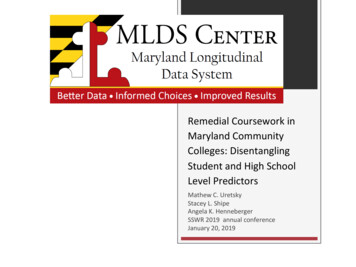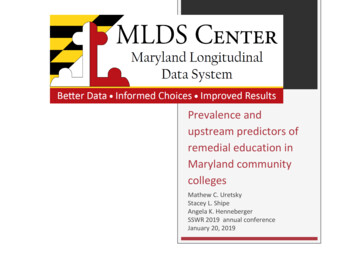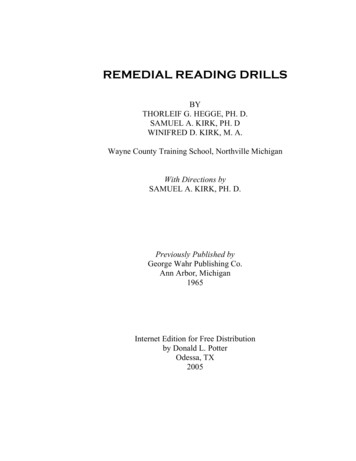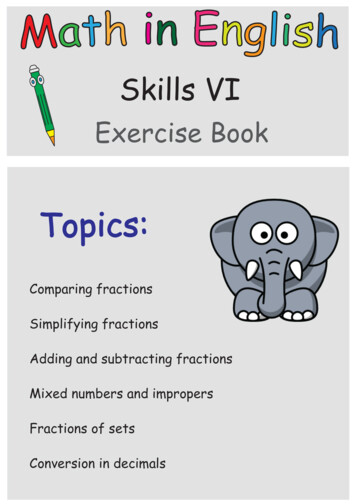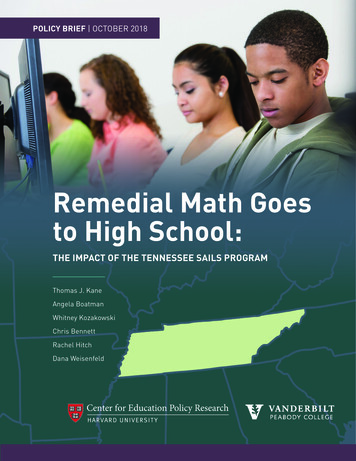
Transcription
POLICY BRIEF OCTOBER 2018Remedial Math Goesto High School:THE IMPACT OF THE TENNESSEE SAILS PROGRAMThomas J. KaneAngela BoatmanWhitney KozakowskiChris BennettRachel HitchDana WeisenfeldCenter for Education Policy Research (CEPR) cepr.harvard.edu1
Ascollege enrollment rates have risen, manystudents are arriving on college campuseswithout the math and literacy skills traditionallyexpected for college-level work. Colleges typicallyrequire such students to complete remedial coursesbefore proceeding to college coursework. Amongfirst- and second-year students at public two-yearinstitutions nationally in 2011-12, 41% took at leastone remedial course (Skomsvold, 2014).an online math course during their senior year.Overseen by the Tennessee Board of Regents, theSAILS program provides support and training tohigh school teachers implementing the SAILS course.Students proceed at their own pace, asking help froma teacher when necessary. Students who complete thecourse’s five modules (about 90% of recent cohorts) areexempted from math remediation if they enroll at anyTennessee community college.Yet, with only 34% of community college students inremediation completing a credential within six years,many have questioned whether remediation does moreharm than good, needlessly delaying students andcosting taxpayers money1 (NCES, 2012). In fact, theadvocacy organization Complete College America hasdecried pre-requisite college remediation as a “bridgeto nowhere” (Complete College America, 2012).A joint team of researchers from Harvard andVanderbilt have been evaluating the impact of SAILSby tracking outcomes of those who were public highschool seniors in Tennessee from 2010-11 through2015-16.With only 34% of communitycollege students in remediationcompleting a credential withinsix years, many have questionedwhether remediation does moreharm than good, needlesslydelaying students and costingtaxpayers money.Tennessee has been a national leader in the effort torethink college remediation, launching the SeamlessAlignment and Integrated Learning Support (SAILS)program in 2012. The goal of the SAILS program hasbeen to shift the timing of remediation from collegeback to high school and, thereby, to allow studentsto enroll in college math directly upon enrolling in acommunity college.Unlike most states where students learn of theirremediation status only after taking a placement testupon arrival at college, Tennessee notifies studentsof their remediation requirements in high school(based on their junior year ACT score), while theystill have time to fill any gaps in their skills. Studentsin SAILS-participating high schools who score belowthe remediation threshold of 19 on the ACT mathtest can fulfill their math remediation by completing2Remedial Math Goes to High School POLICY BRIEFTWO RESEARCH DESIGNSThe design of the SAILS program, and the wayit was rolled out across the state, provide a uniqueopportunity to evaluate its effectiveness, not juston postsecondary course enrollment and creditaccumulation, but also on student achievement inmath as well. Accordingly, we evaluate the programusing two different research designs:First, because high schools adopted the programin different years, we study the changes in studentoutcomes based on the year in which schools beganimplementing SAILS. By focusing on changes inoutcomes, we control for differences in schools’ startingpoints on these outcome measures. By comparing thesame-year changes for SAILS-participating and nonparticipating schools, we also control for other policyreforms that may have affected all Tennessee highschools in any given year.Second, we compare outcomes for students withACT math scores just above and below the cutofffor remediation (a score of 19). Because students oneither side of the cutoff have similar achievement andcharacteristics, such comparisons are akin to randomassignment. Students on one side (below 19) wererecommended for remediation while students on theother side (19 and above) were not. By comparingoutcomes for the two groups of students, we canmeasure the impact of being recommended forremediation. Moreover, by measuring the differencesat the threshold in SAILS-participating and non-
participating high schools, we can compare theconsequences of SAILS remediation to those ofstudents whose only option was pre-requisite orco-requisite remediation. We administered a mathassessment and survey to Tennessee high schoolseniors with ACT math scores above and below 19 tomeasure impacts of remediation.Under Tennessee’s pre-requisite policyBoth approaches, though relying on different statisticalmethods and comparison groups, tell a similar story.SUMMARY OF FINDINGSWe summarize our four primary findings below:1. Under the pre-requisite policy, the SAILSprogram allowed students to enroll in collegelevel math at higher rates. During the firstyear in community college, SAILS participantswere 29 percentage points more likely to enrollin college math. Roughly half of those studentspassed the course, yielding a 13-percentage pointincrease in the percentage of students havingpassed college math by the end of their first year.However, the impacts on college math enrollmentand completion were smaller by the second year,as students from non-participating high schoolscompleted their remediation and caught up.2 Bythe end of their second year in college, SAILSparticipants completed a modest number ofadditional college credits (4.5 credits or 1.5 courses)compared to their counterparts in high schoolswithout SAILS.2. The SAILS program improved students’perceptions of the usefulness and enjoyment ofmath. Students just below the ACT math cutoff of19 (a group much more likely to enroll in SAILS)were 6.5 percentage points more likely to perceivethat their math course content would be useful intheir careers, 10 percentage points more likely toindicate they were better prepared for college math,and 6 percentage points more likely to say that theywere interested in math than those immediatelyabove the remediation threshold, who took adifferent high school math course. The impacts wereparticularly large for Black students.During the first year in community college,SAILS participants were 29 percentagepoints more likely to enroll in college math.Roughly half of those students passed thecourse. However, the passing rates for SAILSgraduates were not higher than for studentswith similar ACT scores who were just abovethe remediation threshold.Credits by 2nd yearBy the end of their second year in college,SAILS participants completed 4.5 additionalcredits (or 1.5 courses) compared to theircounterparts in non-SAILS high schools.Center for Education Policy Research (CEPR) cepr.harvard.edu3
3. Despite the positive impacts on students’perceptions of math, the SAILS program did notimprove students’ math achievement nor boosttheir likelihood of passing college math upontaking the course. We did not find that SAILSparticipation improved performance on any ofthe subsets of items identified by SAILS programstaff as aligned with the SAILS curriculum. Abouthalf of the new students who enrolled in collegemath as a result of SAILS passed the course duringtheir first year in college. The passing rates forSAILS graduates were not higher than for studentswith similar ACT scores who were just above theremediation threshold.4. After the co-requisite policy was introduced inthe fall of 2015, SAILS no longer had an impacton students’ taking or passing college mathduring their first year, nor on the total numberof credits completed at the end of their secondyear. In lifting the barrier to entry into college-levelcourses, the co-requisite policy largely supersededthe SAILS program by allowing students to do theirremediation alongside college-level courses, ratherthan before them. Even though SAILS allowedstudents to avoid having to take remedial classesconcurrently with their college classes, we saw noimpact of SAILS on the number of college creditsstudents completed under the co-requisite policy.DISCUSSIONIn sum, the SAILS program eliminated the delayfor community college students in entering collegelevel math. The adoption of co-requisite remediationin Tennessee’s community colleges in 2015 had asimilar effect. However, the SAILS program did notboost student’s math knowledge nor increase theirchance of passing college math upon taking thecourse. SAILS—like the co-requisite policy—gave30% more remediation-recommended students theopportunity to take college math during their firstyear at community college. And about half of the newentrants passed.In addition to the modest impacts on creditcompletion, taxpayers and students in Tennessee maystill have benefited from the cost reduction SAILS4Remedial Math Goes to High School POLICY BRIEFprovided. Shifting the timing of remediation fromcollege back to high school reduced expenditures oncollege remediation. Because high school studentsin Tennessee are already required to take four yearsof math to graduate, SAILS enrollment did not addto instructional costs in high school. Therefore, anyreduction in expenditures on remediation delivered incollege represented a cost saving.SAILS gave 30% moreremediation-recommendedstudents the opportunity totake college math during theirfirst year at community college.And about half of the newentrants passed.For policymakers nationally, our results are bothgood news and bad news. Critics have pointed topre-requisite remediation as a major cause of noncompletion. The good news is that, in Tennessee atleast, that is not the case. Removing the barrier ofpre-requisite remediation—either with the SAILSprogram or with co-requisite remediation—allowedstudents to make faster progress during their first yearin college, but those advantages were only 4.5 credits(or 1.5 courses) by the end of the second year as thestudents from non-participating high schools caught up.The bad news is that the remedial math course—atleast at the level of intensity required by the SAILSprogram—did not have a discernible impact onstudents’ math knowledge or improve students’likelihood of passing college math upon takingthe course.Achieving significant improvements in the numberof Tennesseans with a postsecondary credentialwill require identifying and clearing other barriersto college completion. For example, in a review ofrecent remedial education reform efforts, Bailey etal. (2016) found that programs with comprehensive,integrated, and long-lasting student supports producedthe largest increases in college success outcomes.Programs like the City University of New York’sAccelerated Study in Associate Programs (ASAP) that
offer students comprehensive advising, tutoring, andfinancial support have been shown to have impactson degree completion (Scrivener et al., 2015). Otherinstitutions, such as Georgia State University, havebeen reaching out to students during the summer,allowing students to choose “meta-majors” withcommon course requirements during their freshmanyear, redesigning their introductory math courses, andautomating parts of their advising system.3 Some ofthese approaches have been tested with comparisongroups and have been shown to produce improvementsin postsecondary access and persistence (Page &Gelbach, 2017), though others have not yet beenevaluated (Kurzweil & Wu, 2015).Achieving significantimprovements in the numberof Tennesseans with apostsecondary credentialwill require identifying andclearing other barriers tocollege completion.purely online (there is a teacher in the room), it ispossible that the self-paced format is less effective forthe students who have struggled with the material inthe past. If states cannot find a model of remediationthat actually increases students’ success in math, weshould be evaluating the consequences of eliminatingremediation requirements for more students.Especially for those without the math and literacyskills traditionally expected for college-level work, weare unlikely to find a single policy to generate largeincreases in college completion. Rather, leaders inTennessee and other states will need to continue toinnovate—and test their ideas with data—in order toachieve substantial change. uuFor more details, read the full report,“Remedial Math Goes to High School: AnEvaluation of the Tennessee SAILS Program,”available at cepr.harvard.edu/sails.ENDNOTESOur findings also suggest a more thorough rethinkingof the content and delivery of remediation. Thefirst task must be finding a model of remediationthat actually improves students’ understanding ofmath. It could be that senior year in high school istoo late to start. In a study of the effectiveness of adouble-period algebra course in the 9th grade in theChicago Public Schools, researchers found positiveimpacts on students’ achievement in algebra (Nomi& Allensworth, 2009). Later work found positiveimpacts on credits earned in high school, test scores,high school graduation, and college enrollment rates(Cortes, Goodman, & Nomi, 2015).1 Estimate based on Beginning Postsecondary Students(BPS): 2009 transcript data (NCES 2012; tables accessed viaQuickStats at https://nces.ed.gov/datalab/index.aspx).2 It is also possible that the co-requisite policy implementedduring their second year helped shrink the difference.3 Other states have begun using high school grades incombination with test scores for making remediation decisions.A recent study in New York found that some of the studentsexempted from remediation based on a combined measurewere able to pass college math (Barnett et al., 2018). Thesefindings support earlier research with similar conclusions(Belfield & Crosta, 2012; Scott-Clayton & Rodriguez, 2012;Scott-Clayton, Crosta, & Belfield, 2014).It is also possible that other modes of instruction oradditional layers of support might be more effectivefor students. A growing body of work from collegeand high school settings has found that students withlower levels of academic preparation perform less wellin online courses than with traditional instruction(Xu & Jaggars, 2013; Bettinger, Fox, Loeb, & Taylor,2017; Heppen, et al., 2016). Although SAILS is notCenter for Education Policy Research (CEPR) cepr.harvard.edu5
SUGGESTED CITATIONKane, T., Boatman, A., Kozakowski, W., Bennett, C., Hitch, R., & Weisenfeld, D. (2018). Remedial math goes tohigh school: The Impact of the Tennessee SAILS program. Policy Brief. Cambridge, MA: Center for Education PolicyResearch, Harvard University.REFERENCESBailey, T., Bashford, J., Boatman, A., Squires, J., & Weiss,M. (2016). IES practice guide: Strategies for postsecondarystudents in developmental education – A practice guide forcollege and university administrators, advisors, and faculty. U.SDepartment of Education, Institute for Education Sciences. Retrieved from t, E.A.,Bergman, P., Kopko, E., Reddy, V., Belfield,C.R., & Roy, S. (2018). Multiple measures placement usingdata analytics an implementation and early impacts report.The Center for the Analysis of Postsecondary Readinessand MDRC. Retrieved from r files/media/CAPR 20reportfinal%20%281%29.pdfBelfield, C.R., Crosta, P.M. (2012). Predicting success incollege: The importance of placement tests and high schooltranscripts (Working Paper No. 42). Community CollegeResearch Center: Teachers College, Columbia University.Retrieved from Bettinger, E.P., Fox, L., Loeb, S., & Taylor, E. (2017). Virtual classrooms: How online college courses affect studentsuccess. American Economic Review, 107(9), 2855.Complete College America. (2012). Remediation: Highereducation’s bridge to nowhere. Retrieved from tes, K.E., Goodman, J.S., & Nomi, T. (2015). Intensivemath instruction and educational attainment: Long-runimpacts of double-dose algebra. Journal of Human Resources,50(1), 108-158.Heppen, J. B., Sorensen, N., Allensworth, E., Walters, K.,Rickles, J., Taylor, S. S., & Michelman, V. (2017). The struggle to pass algebra: Online vs. face-to-face credit recoveryfor at-risk urban students. Journal of Research on EducationalEffectiveness, 10(2), 272-296.6Remedial Math Goes to High School POLICY BRIEFKurzweil, M., & Wu, D.D. (2015). Building a pathway tostudent success at Georgie State University (Case Study). NewYork: ITHAKA S R.National Center for Education Statistics (NCES). (2012).QuickStats: Beginning postsecondary students database for2003/2004 entrants. Washington, DC: U.S. Department ofEducation, Institute of Education Sciences. Retrieved fromhttps://nces.ed.gov/datalab/index.aspxNomi, T., & Allensworth, E. (2009). Double-dose algebraas an alternative strategy to remediation: Effects on students’ academic outcomes. Journal of Research on EducationalEffectiveness, 2(2), 111-148.Page, L., & Gehlbach, H. (2017). How an artificially intelligent virtual assistant helps students navigatethe road to college. AERA Open, 3(4), 1-12. ton, J., Crosta, P.M., & Belfield, C.R. (2014).Improving the targeting of treatment: Evidence fromcollege remediation. Educational Evaluation and PolicyAnalysis, 36(3), 371–393. http://epa. 935Scott-Clayton, J., & Rodriguez, O. (2012). Development,discouragement, or diversion? New evidence on the effects ofcollege remediation. National Bureau of Economic Research(Working Paper No. 18328). Cambridge, MA: NBER.Scrivener, S., Weiss, M.J., Ratledge, A., Rudd, T., Sommo,C., & Fresques, H. (2015). Doubling graduation rates: ThreeYear effects of CUNY’s Accelerated Study in Associate Programs(ASAP) for developmental education students. New York, NY:MDRC.Skomsvold, P. (2014). Profile of undergraduate students:2011–12 (NCES 2015-167). National Center for Education Statistics, Institute of Education Sciences, U.S. Department of Education. Washington, DC.Xu, D., & Jaggars, S.S.(2013). The impact of online learningon students’ course outcomes: Evidence from a large community and technical college system. Economics of EducationReview, 37(C),46-57.
in SAILS-participating high schools who score below the remediation threshold of 19 on the ACT math test can fulfill their math remediation by completing an online math course during their senior year. Overseen by the Tennessee Board of Regents, the SAILS program provides support and training to high school teachers implementing the SAILS course.

